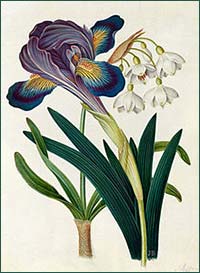Hebden Bridge Local History Society
The trials and tribulations of the Calder Valley Naturalists
Speaker: Richard Rainbow
Thursday, 29 December 2022
 The Calder Valley has for centuries been a rich landscape for the study of nature. A 17th century list of British flora records two rare plants in the valley: Wintergreen growing 'plentifully' at Northbridge in Halifax, and in a single location, on a great stone near Widdop, a very rare bearberry with its bright red berries. Richard Rainbow, in his talk to Hebden Bridge Local History Society, was keen to share the stories of local naturalists who made an impact on the scientific study of plants.
The Calder Valley has for centuries been a rich landscape for the study of nature. A 17th century list of British flora records two rare plants in the valley: Wintergreen growing 'plentifully' at Northbridge in Halifax, and in a single location, on a great stone near Widdop, a very rare bearberry with its bright red berries. Richard Rainbow, in his talk to Hebden Bridge Local History Society, was keen to share the stories of local naturalists who made an impact on the scientific study of plants.
After Carl Linnaeus developed his classification system of plant species in the eighteenth century, a sense that there was order and purpose in nature led to a surge in interest and a desire to explore and discover new species. James Bolton (1735 – 1799), from Warley, was one such man, whose catalogue of plants growing locally is an appendix in Watson's The History and Antiquities of the Parish of Halifax. He was a self-taught naturalist who recorded his observations in exquisite watercolours which caught the attention of lavish patron of science, the Duchess of Portland.
His first book was about ferns, which grew prolifically in the Calder Valley, including the rare Killarney fern, was a huge success, feeding into a mania for collecting ferns which threatened to strip the countryside, and leading to the condemnation of the 'reckless uprooters of rareties'.
His second book, sponsored by the Earl of Gainsborough, also drew on the diversity of fungi in the valley, which provided a natural botanic garden. Bolton's observations led to 73 new species being named after him. Given the longevity of fungi, the same 'woolly foot' he discovered near Northowram is still growing in Shibden Park today.
For his final book he returned to his first love, birds, and we can see something of his methods in a letter to a friend in Illingworth, listing the specimens he needed (shot) and offering to pay local boys to collect eggs and nests. He died in Warley, but there is no memorial to the once famous man anywhere in Calderdale.
Another local naturalist, Samuel Gibson (1790 – 1849), lived at the Royal Oak in Mytholmroyd and decided to follow his passion for nature by setting up a natural history museum there. He contributed to Baines' Flora of Yorkshire and to leading journals such as The Phytologist.
Convinced he had discovered a new genus of hawkweed and of a species of carex grass, he fought a fierce battle in print with other experts, until suggestions of scurrilous behaviour led the journal to silence him. Soon after he closed his museum and took his own life. His belief in his own observations was posthumously justified when in 2018 his hawkweed was confirmed as a new distinct species and named S Gibson, in recognition.
The story of John Nowell (1802 – 1867) is a happier one. He was a Todmorden textile worker, who was fascinated by the diversity of mosses in the Calder Valley – 250 different species. He had microscopic vision which enabled him to pick out details and identify species without the aid of a magnifier. He stayed in Todmorden and was something of a local hero with his expertise on mosses.
Fungi was a subject which fascinated James Needham (1849 – 1913) and his studies put Hebden Bridge on the map in the world of mycology, when he submitted his findings to The Naturalist. One of his discoveries was a liverwort special to Calder Valley.
Some of the collections of James Bolton are held at Kew, and 5000 of James Needham's meticulous recording cards are in the Birchcliffe archive. Samuel Gibson's collection was thought to have been lost when an over enthusiastic clear-out was undertaken at Todmorden Library, but recently local researcher Heather Morris discovered that thousands of his collected species are held by the Manchester Museum.
When it comes to the legacies of these local naturalists, there is clearly a need for more widespread knowledge and recognition of their achievements. Richard Rainbow is determined to build on their legacies, and has resurrected the Hebden Bridge Natural History Society for 21st century enthusiasts. There is already an impressive website and details of activities, search www.hebnat.org.uk
On January 11th Diana Monahan and Justine Wyatt will be helping us to discover The Upper Calder Valley landscape in the paintings of John Holland.
Details of the History Society talks programme, publications and of archive opening times are available on the History website and you can also follow History Society Facebook page.
With thanks to Sheila Graham for this report
See also: the HebWeb History section

